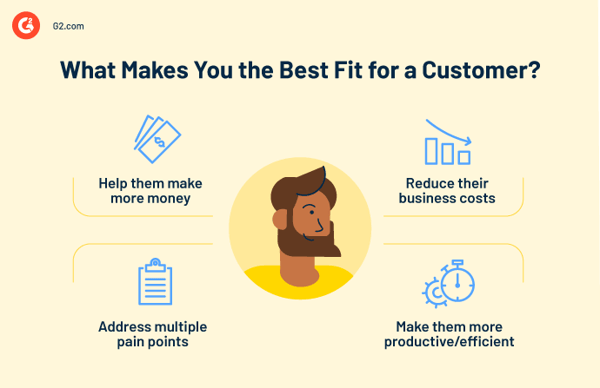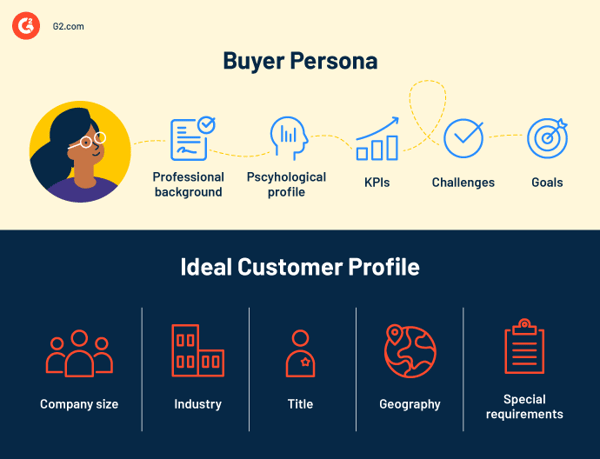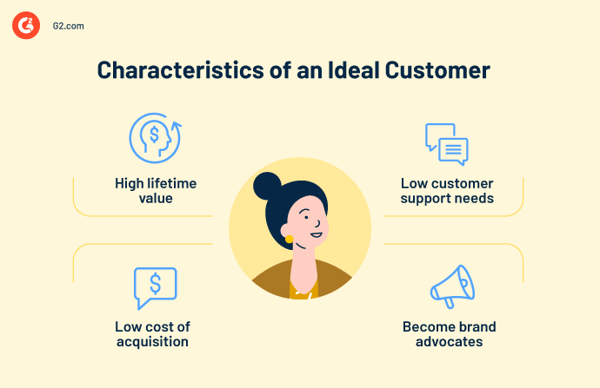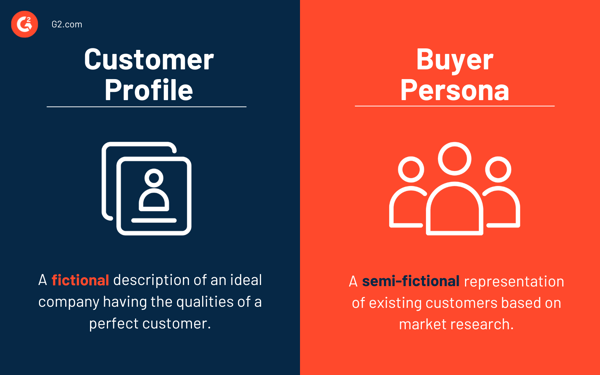

The days of mass marketing are behind us.
Businesses no longer need to send out advertisements to an entire market and hope for the best. With the right market research, you can reach your target audience and deliver an experience that caters to their needs.
But, to reach your target customers, you must know who they are. That’s why creating an ideal customer profile (ICP) is the way to go. Customer profiling empowers businesses to identify and target high-quality leads by providing detailed descriptions of people most likely to purchase their products and services.
A customer profile summarizes an ideal customer and their interactions with a brand. It details customer pain points, motivations, fears, likes, dislikes, and buying patterns, allowing businesses to target similar customers during their marketing campaigns.
Many businesses use customer data platforms (CDPs) to understand their audience. It consolidates and integrates customer data from multiple sources like websites, mobile apps, and email platforms into one database. This data can then be used to create ICPs.
Building customer profiles will allow you to run better campaigns by providing data-driven insights to refine a marketing strategy. This is especially valuable for businesses with multiple product lines targeting different types of customers.
ICPs are vital for designing a marketing or business strategy. Knowing one buyer who will surely buy from you is far more valuable than targeting groups elsewhere. With customer profiling, you can narrow your approach and create targeted solutions instead of providing solutions spread over a large group, resulting in diluted results.
Customer profiles are important for understanding your ideal customer's motivations, fears, and communication styles. When used correctly in sales, marketing, and product development, it can increase your number of satisfied customers.
Marketing teams can use customer profiles to tailor their messaging for various campaigns, improving their chances of converting prospects. Sales teams can determine how to approach a customer given how likely they are to purchase a product. Support teams can use ICPs to provide personalized customer service by targeting specific demands.
Not everyone is motivated by the same things, and that means different sales tactics should be used depending on who you're dealing with. So, having multiple customer profiles is always better.
of consumers said they would leave a brand after as few as two poor experiences.
Source: emplifi
Your brand is unique, so your customer profile will also be unique. So don't be afraid to branch out. Here are some examples of customer profiles to get you started.
Customer segments divide customer data by common needs and factors like demographics, values, and preferred communication channels. This data helps marketers to create the best advertising strategy that resonates with this group of customers.
Elements like demographics, psychographics, and behavior draw a high-end overview of customers. By dividing customer profiles into these categories, marketers can understand what their customers like to buy and how.
A buyer persona is a perfect tool for asking critical questions that complete your customer profile and answer key questions. It helps businesses visualize their target audience and tailor their solutions to suit them perfectly.
This type of customer profile includes determining a set of abilities you want your customers to possess, such as needs, time, budget, etc. Then set a scoring metric on three parameters: no fit, workable fit, and perfect fit. Measure these scores and rank your prospects to find the ideal customer.
Never created an ICP before? Use our free customer profile template to get started.
Think of customer profiles like creating a Sims character. You’re building an avatar, a persona that describes a wide swath of your customers. Of course, each customer is unique, but for the sake of marketing, it’s better to group customers together based on their similarities.
Let's dive into the step-by-step process of creating a customer profile.
Identifying your ideal customer is worthless if that customer doesn't help you reach your goals. What is the biggest focus your company has this year? Is it X number of sales of a product? More sign-ups on your website? Increased social media followers? A customer profile can help you achieve all of those.
Once you've identified your goals, you can focus on how the customer works into them. A hundred new purchases of ABC products won't matter if your goal is to sell XYZ products. Your goals and your target customers should align perfectly.
The hard truth is that your business isn't the only one targeting your ideal customer. That's why focusing on what makes your brand or product unique is crucial.

Think about the last product you bought. It was probably because it stood out in a unique way and caught your attention. Pinpointing these differences is the first step in convincing a potential customer that you can solve their problem better than a competitor.
One thing we see here at G2 a lot is brands using their G2 Grid Score to highlight customer satisfaction to potential leads. These verified user reviews are coming from current customers and help companies highlight what real users love about their products.
Once you've pinpointed your long-term goals and what makes your product unique, it's time to put that into perspective with your ideal customer. Your buyer persona should outline a few high-level things about a potential customer, which will help you build your customer profile. These two things work together to create the perfect strategy for attracting new customers.

Here are a few things you should remember about a potential customer.
These are the basic facts about your customers. You can probably glean this information simply by observing them. Important demographic information includes age, city, gender, race, ethnicity, etc.
For example, if you want to sell customer relationship management (CRM) software, your ideal customer probably works in the marketing department. You would likely want to target the chief marketing officer (CMO) because they are the decision-makers who understand your product's importance.
Socioeconomic considerations include household income, education, neighborhood, occupation, and composition.
This can also translate into what type of business your ideal customer works for. If you know your product is pricey, targeting enterprise companies rather than small businesses might be best to maximize your success chances.
This includes interests, hobbies, favorite TV shows (and music, websites, media, etc.), spending habits, anxieties, and political views, to name a few.
If you know your ideal customer reads a certain industry blog or website, writing a guest blog on that website could be beneficial to get your product or business in front of that customer. You could also regularly interact with certain social media accounts you know your ideal customer follows.
Why do customers use your brand? What do they get out of it? How often do they use the product or receive the service? Knowing how loyal your customers are is important, as there is spending power behind customer loyalty.
Evaluate whether your ideal customer is already loyal to another brand. How can you flip them to becoming a loyal customer of yours? Is it worth trying? What makes them like another brand, and does your brand do it better? These are all things to consider.
One more thing you should consider is what makes a great customer. It might be tempting to go after the biggest companies with the most high-profile leaders – but that doesn't always make someone a good customer.

Once you've collected all that information, you can put it together and create your buyer persona.
A customer profile is often used interchangeably with a buyer persona because both of these terms describe customers based on factors like demographics, psychographics, and buying patterns. However, there is a slight difference between them.
A customer profile is most commonly used in B2B companies. It defines the characteristics of a company that is the perfect customer for your products. It’s perfect for businesses that practice account-based advertising because they can focus on selling to targeted accounts.
On the other hand, a buyer persona is a generalized representation of your customers. It uses market research to define the best-fit demographic to which you should cater your product or service.

Both of these concepts are linked, so a business must work with customer profiles and buyer personas together. Since nothing is permanent in a competitive market, remember to revisit your ICPs and personas to stay relevant and successful in your approach.
After aggregating this data about your customers, group them into buckets based on similarities. Most likely, you will have more than one customer profile.
Once created, customer profiles can help you decide which PR campaign to embark on. These can help your brand awareness and bring new customers into the sales pipeline you might have missed.
Customer profiles can also guide your marketing plan. Now you know which medium will most effectively reach your customers: TV ads, Facebook, in-store promotions, Pinterest, newspaper, direct mail, Twitter, radio, etc.
You’ll know which promotions your customers are most interested in. This could include events, giveaways, new products, demos, or discounts. And you’ll know what images, fonts, colors, jokes, and references will catch their attention.
Customer profiles will also reveal what you can do to convince customers that your offer is the best. You can alleviate anxiety by touting warranties, exceptional customer service, guarantees, etc.
This exercise shows what will not work, which is equally as important as knowing what will. For example, don't reference I Love Lucy if your client base is in high school. Or if your customers tend to be above 55 years old, don’t use tiny, hard-to-read fonts.
On the sales side, you can use CRM software to help you sort all the information you gathered and strategize appropriately. The software can help you pair up customer profiles with individual leads and prospects, so you can use similar sales pitches to the marketing messaging you used for those customers.
Take a moment to think back on your experience as a consumer. Have you ever received an ad or promotion that just spoke to you? Almost like they knew you?
Don't worry, they're not listening to your conversations through your iPhone. This hyper-targeted message is actually the work of a marketing team that built the perfect customer profile.
The business contacting you took significant time, effort, and research to conduct customer data analysis and get to know you, so they can talk to you like a trusted friend. The marketing team knows exactly what images will appeal to you, what social media channel to reach you on, and what time of year you’d like to buy the product or service.
When your business qualifies for a lead, you're essentially scoring how likely they are to purchase your product. When creating a customer profile, you create the playbook to convert that high-profile lead into a sale.
Without the right communication strategy, sales talking points, or understanding of what motivates the buyer, you might as well forget lead qualifying. It's not enough to know someone might purchase from you. You must know what tactics will make them sign on the dotted line.
Customer profiling helps you achieve that. Once you understand the customer's motivation, fears, and desires, you can create the playbook for your sales team to lead them to an easy close.
Becoming familiar with your brand and customers takes a lot of time. New employees often take months to familiarize themselves with the brand and its products.
A robust customer profile can help these employees skip the learning curve and become more familiar with your company and its offerings faster and more efficiently. This means less time in training and more time chasing down those high-profile deals you're looking to close.
Whether you work in sales, product, or marketing, chances are you've worked with internal communications software before. Maybe your team rolled out a new feature; everyone must know how to discuss it.
Customer profiles serve the same purpose when speaking with potential leads. It allows everyone to be on the same page and strategize how certain customers like being communicated with, what motivates them, and what turns them off.
If your marketing or sales efforts aren’t striking gold, take a time-out and evaluate your customers. Think about what it is you need to know so you can satisfy their needs. Decide what research method to use to gather this data: email surveys, focus groups, face-to-face feedback, etc. This exercise may take some time, but it’s worth it.
Remember, if you don’t know who you are selling to, you can’t know how to sell.
Want to learn more ways to build meaningful customer relationships? Read everything there is to know about experiential marketing and how it can take your efforts to the next level.
This article was originally published in 2018. It has been updated with new information.

Use customer data platforms to get a 360-degree view of your audience and create the right customer profiles.
Holly is the director of content marketing at G2. An avid reader and writer, Holly graduated from the University of Missouri with a dual major in Journalism and English. She firmly believes in the power of content and is constantly seeking ways to better engage and delight readers.

Use customer data platforms to get a 360-degree view of your audience and create the right customer profiles.
First impressions matter.
 by Mohammad Farooq
by Mohammad Farooq
Employee journey mapping is a crucial part of HR processes.
 by Ramiah Adeen
by Ramiah Adeen
Why do you need a buyer persona? Let’s consider this hypothetical situation.
 by Ian Blair
by Ian Blair
First impressions matter.
 by Mohammad Farooq
by Mohammad Farooq
Employee journey mapping is a crucial part of HR processes.
 by Ramiah Adeen
by Ramiah Adeen
Never miss a post.
Subscribe to keep your fingers on the tech pulse.



